HOW AI IS BREAKING POKER
AND WHAT REAL PLAYERS CAN DO ABOUT IT
How AI Is Changing Poker! For nearly a millennium, humans have engaged in games resembling poker, each iteration reflecting the cultural nuances of its time. From the domino-card games played by Chinese emperors in the 10th century to the Persian game of As Nas in the 16th century, the essence of poker has traversed continents and centuries . The French game Poque, derived from the German Pochen and the Spanish Primero, introduced elements like bluffing and strategic betting, laying the groundwork for modern poker
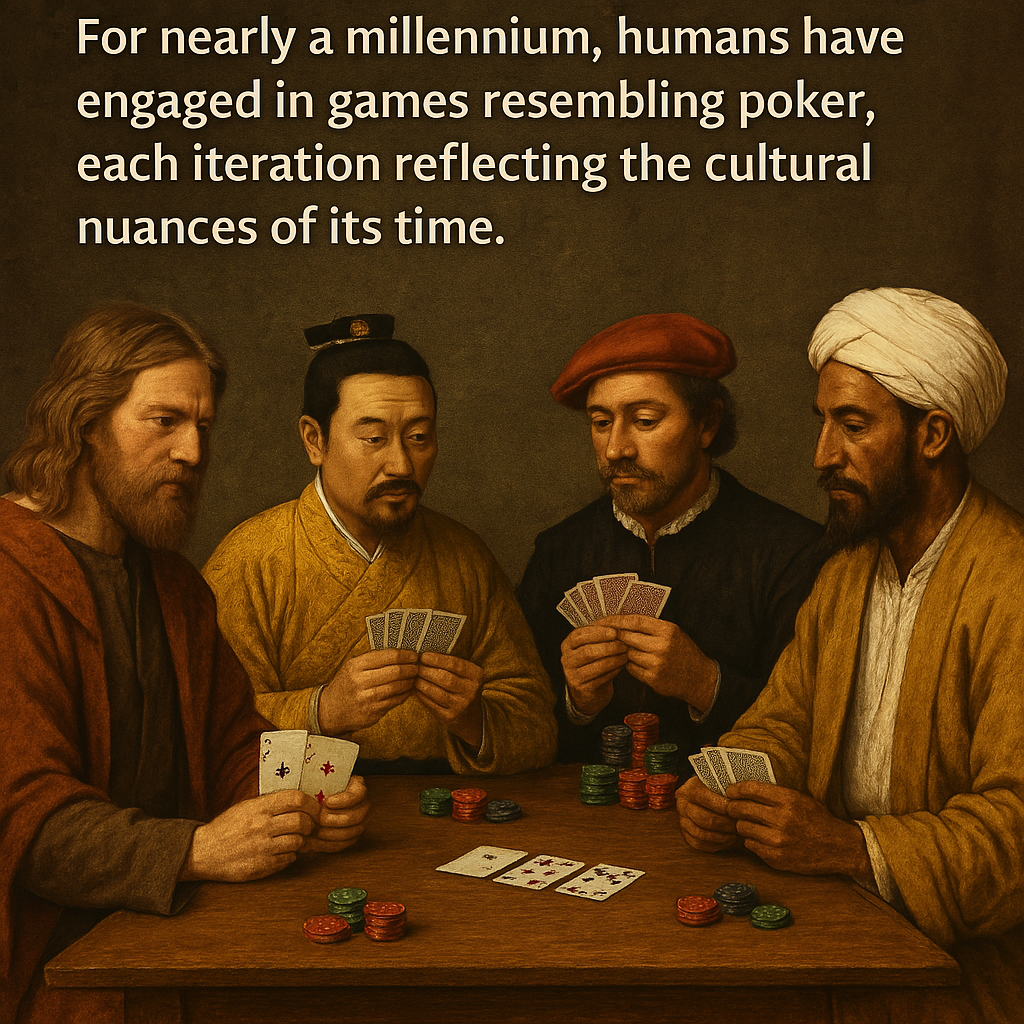
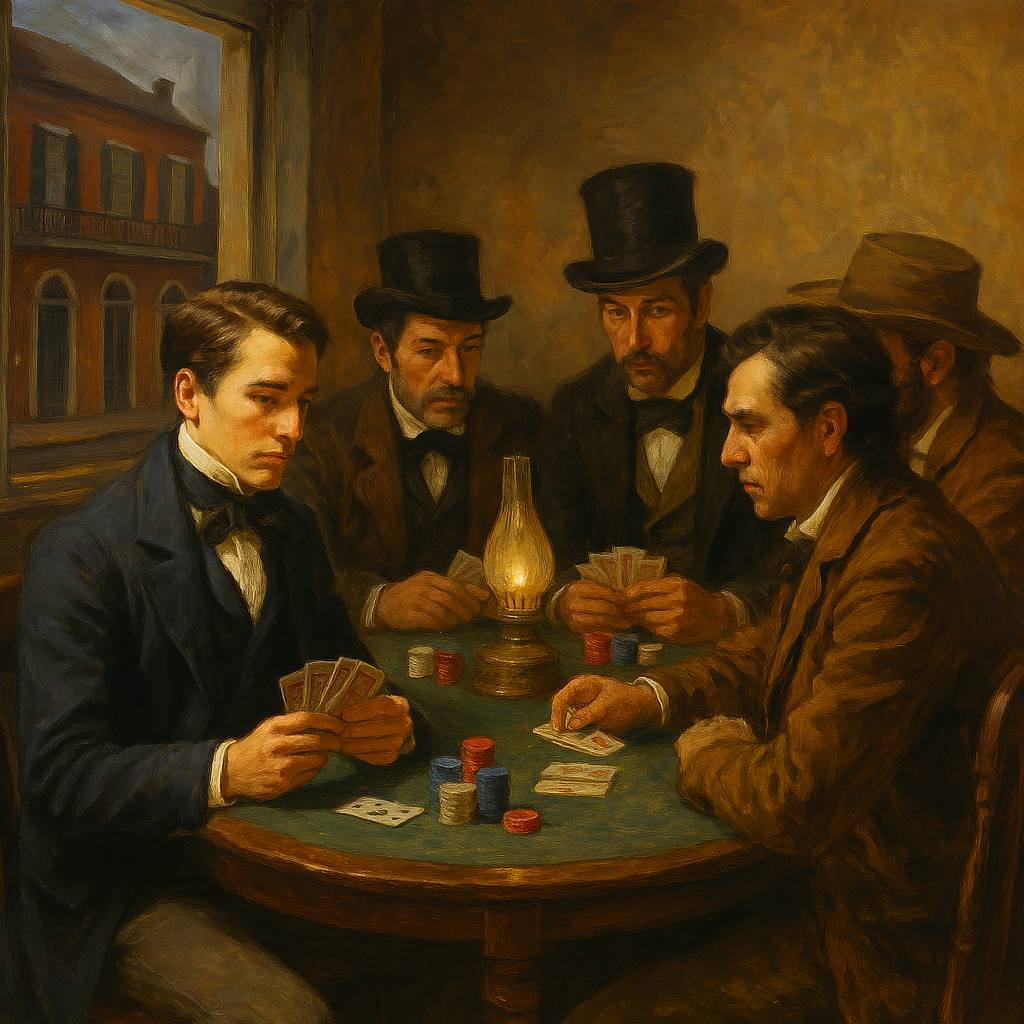
In the early 19th century, French colonists brought Poque to New Orleans, where it evolved into the poker we recognize today. By 1834, the game had adopted a 52-card deck, and its popularity spread along the Mississippi River, becoming a staple among soldiers and settlers .
For generations, poker has been more than just a card game; it’s a reflection of human psychology, strategy, and the art of reading opponents. But now, as artificial intelligence begins to master the intricacies of the game, we face a pivotal question:
HOW AI IS CHANGING POKER. WHAT DOES THIS MEAN FOR THE FUTURE OF HUMAN COMPETITION?
THE RISE OF ARTIFICIAL INTELLIGENCE IN POKER
SO WHO LIT THE FUSE?
Poker, with its blend of strategy, psychology, and incomplete information, has long been considered a benchmark for testing artificial intelligence. Unlike games like chess or Go, where all information is visible, poker requires players to make decisions based on hidden cards and unpredictable human behavior. This complexity made poker a formidable challenge for AI researchers.
If poker has always been a game of humans, when did the machines start to matter — and who pushed them into the pot?
Let’s take a brief walk through the key milestones in AI’s rise through the poker world.
.
EARLY ENDEAVORS: 1980 tHROUGH 1990
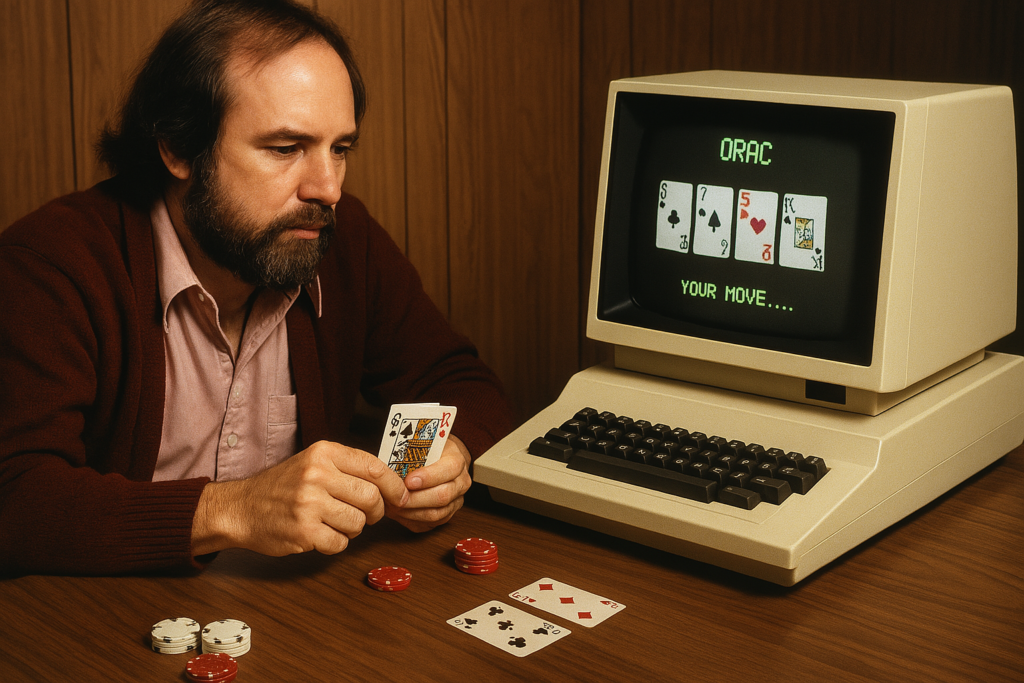
1984: Mike Caro developed “Orac,” one of the first poker-playing programs, designed to participate in the World Series of Poker. While rudimentary, it marked the beginning of AI’s journey into poker.
1990s: The University of Alberta’s Computer Poker Research Group, led by Jonathan Schaeffer, introduced “Poki,” a program that utilized Monte Carlo simulations for decision-making. This laid the groundwork for future AI developments in poker. .
HOW AI IS CHANGING POKER - ADVANCEMENTS IN THE 200O'S
2005: The emergence of online poker bots like “WinHoldEm” sparked controversy. These bots could play autonomously, raising concerns about fairness and the integrity of online poker games.
2007: “Polaris,” developed by the University of Alberta, competed against professional players Phil Laak and Ali Eslami. In a series of matches, Polaris demonstrated that AI could challenge human professionals, winning two out of four matches.
BREAKTHROUGHS IN THE 2010'S
2015
2017
2019
“Claudico,” an AI developed by Carnegie Mellon University, faced off against top human players in a 13-day tournament. While Claudico lost, the narrow margin highlighted AI’s rapid progress.
“Libratus,” another AI from Carnegie Mellon, defeated four professional players over 120,000 hands, winning by a significant margin. Libratus’s success was attributed to its ability to adapt strategies in real-time and its advanced game-theoretic algorithms.
“Pluribus,” developed by Facebook AI and Carnegie Mellon, became the first AI to defeat multiple human players in six-player no-limit Texas Hold’em games. Pluribus’s efficiency and strategic depth marked a significant milestone in AI research.
THE ERA OF REAL-TIME ASSISTANCE (RTA)
As AI tools became more accessible, some players began using real time assistance (RTA) software during online games. These tools provide optimal plays based on game theory, giving users an unfair advantage. Major poker platforms have since implemented measures to detect and ban RTA usage, emphasizing the ongoing battle between fair play and technological exploitation.
The integration of AI into poker has reshaped the landscape of the game. From early experimental programs to sophisticated systems capable of outplaying professionals, AI’s evolution in poker reflects broader trends in technology’s role in human activities. As we move forward, the challenge lies in balancing technological advancements with the essence of human competition.
For nearly 1,000 years, poker has been a contest of human instinct — across cultures, continents, and centuries. But in the last two decades, something new has entered the game.
A machine.
And not just to deal the cards — but to play them. Better than us.
THE CENTRAL QUESTION IS THIS: WHEN THE MACHINE PLAYS BETTER ...SHOULD WE STILL PLAY?
HOW AI IS CHANGING POKER - THE TOOLS THAT CHANGED THE GAME
“The tools we build shape the games we play — and eventually, they reshape the players themselves.”
To understand how AI is changing poker, we have to follow the tools. Not just the bots and solvers — but the silent, steady rise of technology that’s shifted the very nature of decision-making at the table. What began as academic curiosity has now become an arms race — not between players, but between humans and their own machines.
Let’s walk through the progression, not just chronologically, but evolutionarily — one leap at a time.
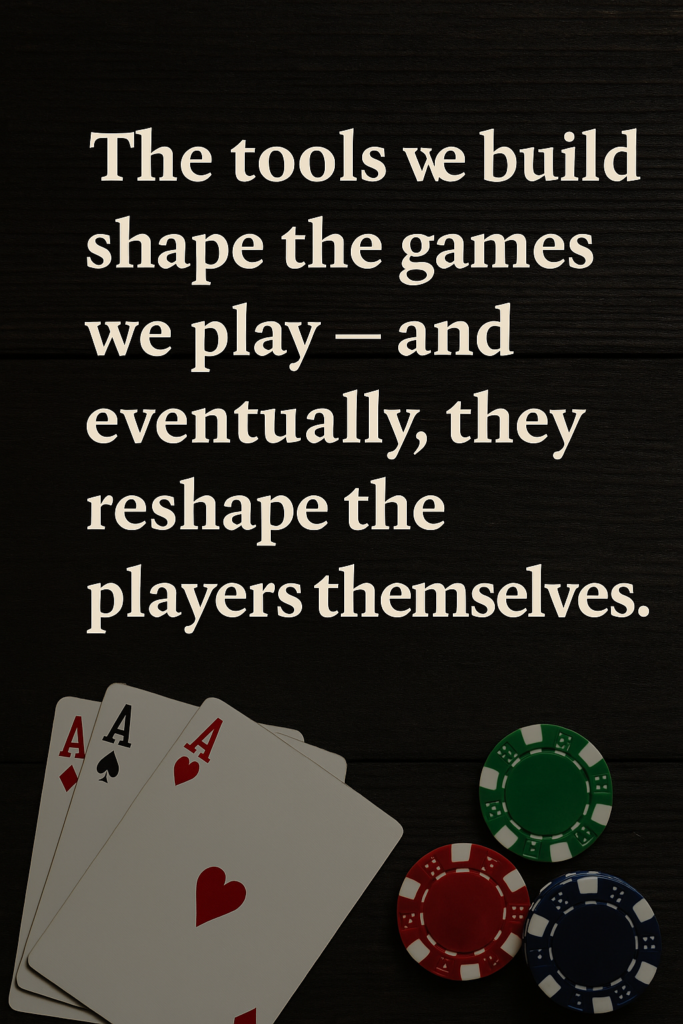
THE SOLVER REVOLUTION-TEACHING THE MACHING TO LEARN (2013-2017)
Key Players: Claudico → Libratus (Carnegie Mellon)
Here’s where it changed. Claudico was an attempt. Libratus was a breakthrough.
- 2015 – Claudico: Played 80,000 hands vs elite pros. It lost — but narrowly. Analysts were shocked at how close it was.
“It made weird bets, but it didn’t make bad ones.” — Jason Les, pro player
- 2017 – Libratus: Played 120,000 hands vs four top heads-up pros. It won decisively — by over $1.7 million in chips.
Libratus rebuilt its strategy each night using machine learning and game-theory refinements.🎯 Impact:
- Proved that perfect theoretical poker could beat top human players — in heads-up no-limit.
- For the first time, humans weren’t just out-calculated — they were outplayed over a long sample.
SOLVERS GO PUBLIC - (KEY TOOLS: PIOSOLVER, GTO+ & SIMPLE POSTFLOP)
Following Libratus, solver technology became commercialized. You didn’t need a supercomputer anymore — just a subscription.
2018: PioSolver became the first mainstream GTO solver. Players could now analyze any spot using equilibrium-based strategies.
2019–2020: Tools like GTO+ and Simple Postflop made it even easier. Now, even mid-stakes grinders were training daily with solvers, adjusting bet sizes, and mimicking equilibrium play.
Studies began showing that online winrates dropped as solver-trained players began dominating.
Quote: “You can’t beat regs without solver study anymore.” — 2+2 forum
🎯 Impact:
- The style of play changed: smaller bet sizes, polarized ranges, auto-cbets
- Players who didn’t use solvers found themselves outpaced — even at small stakes
- Poker began to feel… robotic
.
THE PLURIBUS THRESHOLD: WHEN AI BECAME A TABLE-WIDE THREAT

“Heads-up was a science experiment. This… this was war.”
When Pluribus emerged in 2019, it quietly solved what many believed was the unsolvable problem in artificial intelligence: how to dominate multi-player poker — specifically, six-max no-limit Texas Hold’em — in real time, against multiple human opponents, with hidden information, without requiring massive compute power.
And that changed everything.
WHAT MADE PLURIBUS SO DIFFERENT?
HOW DID IT WORK?
Libratus (2017) was powerful — but it only played heads-up. It beat elite pros like Jason Les and Dong Kim in a highly controlled setting. A breakthrough, yes — but heads-up no-limit is far simpler than real poker’s most common format: multiway, full-ring, messy, human-inflected chaos.
Pluribus changed that.
It didn’t just compete in a full six-player game — it won convincingly, beating five human players at once over thousands of hands. The players included WSOP bracelet winners and high-stakes regulars.
“The AI was relentless. It bluffed in ways we weren’t ready for. And it never tilted.”
— Chris Ferguson (not the pro, a CMU researcher)
Instead of relying on massive server farms or off-the-chart computing power, Pluribus introduced two key innovations:
- Limited Lookahead:
It didn’t try to calculate every future action — it stopped at a few moves ahead and adjusted constantly.
This mirrored how humans play — making it faster and more adaptable. - Self-Play + Abstraction:
It trained by playing trillions of hands against itself, then abstracted game states into manageable decision chunks.
It essentially learned how to generalize — and how to bluff in new, unpredictable ways.
WHY IT BLEW EVERYONE'S MIND
Poker was the gold standard of imperfect information games. Everyone assumed that adding more players would make it too complex to solve — too many unknowns, too many interactions.
But Pluribus didn’t care.
It played fearlessly. It invented new bluff lines that humans hadn’t seen before. It balanced its ranges without relying on memory or HUDs. And it never deviated from its goals.
In short: It beat humans at our own game. Not by copying us — but by being something entirely other.
WHAT IT ALL MEANS!
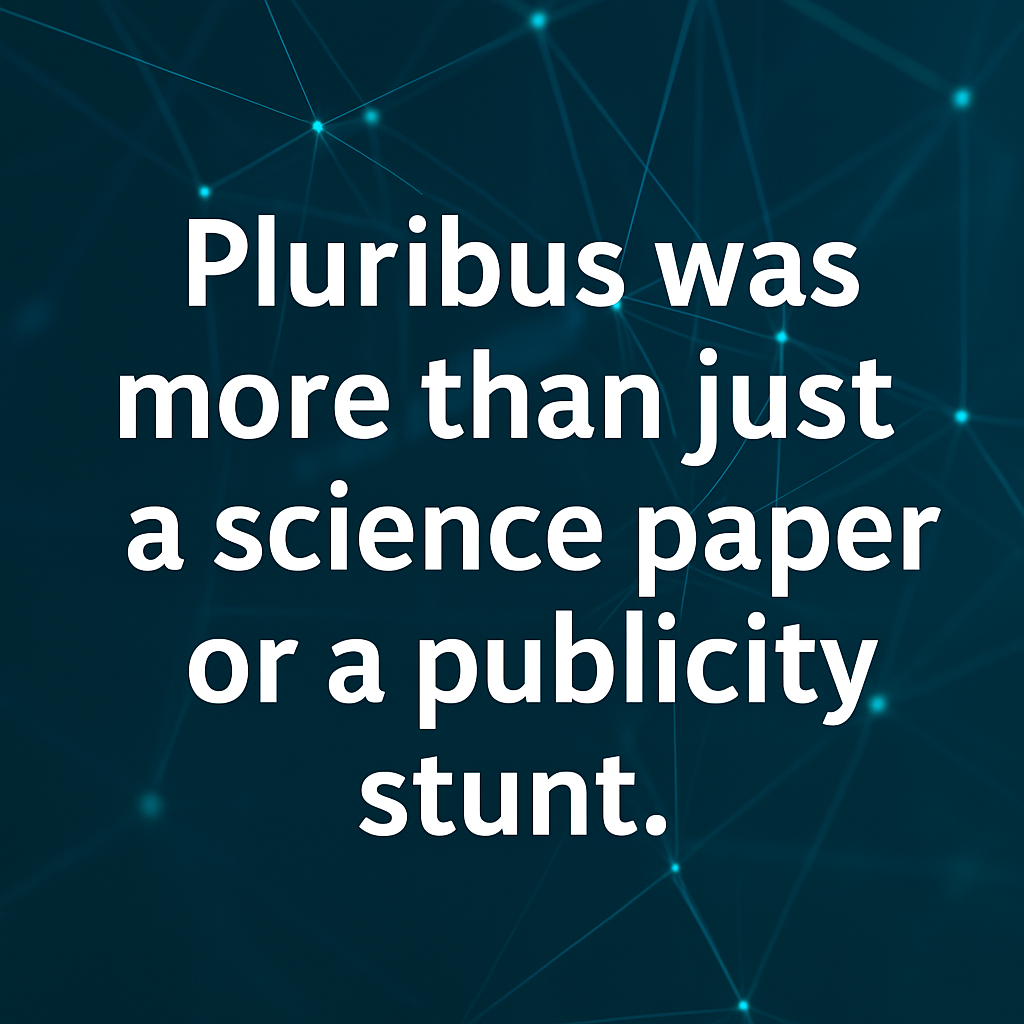
Pluribus was more than just a science paper or a publicity stunt. It was the moment poker crossed a line — when six players at the table no longer meant six humans.
It proved that even the messy, emotional, irrational world of multi-way poker could be tamed — not with brute force, but with elegant code.
And as we move further into the age of assistive AI, the question isn’t whether machines can beat us.
It’s whether we still want to play the same game they’re playing.
SIDEBAR: HOW TO SPOT A PLURIBUS-STYLE BOT IN YOUR GAME
Not all bots are Pluribus. But some are trying to be.
While Pluribus itself isn’t available to the public, its blueprint — multi-player range balancing, adaptive bluffing, and unemotional precision — has made its way into the underground. If you’re playing online in 2025, especially on mid-to-low stakes cash tables, here are the signs you might be facing a Pluribus-inspired bot or RTA user:
ROBOTIC TIMING-ALWAYS SMOOTH, NEVER RUSHED
HYPER-ACCURATE BET SIZING
NO EGO, NO EMOTION, NO TILT - EVER
Human players hesitate, stall, speed up, or time-bait.
Pluribus-style bots use precisely measured bet timings — not too fast, not too slow.
Watch for players who never deviate from a natural-seeming rhythm.
✅ Tip: Use the time-bank pattern as a signal — bots rarely vary under pressure.
Bet sizes are often solver-perfect — 33%, 66%, 125%, etc.
They’ll switch from small to polarizing bets based purely on board texture — no hesitation.
You’ll notice unusual lines that seem odd… until you realize they’re unexploitable.
✅ Tip: Look for oddly “perfect” value bets on scary boards — bots balance better than humans.
Bots don’t revenge-bet. They don’t spew. They don’t slowroll.
After losing a massive pot, they continue on as if nothing happened — because nothing did.
✅ Tip: Mark a player who suffers a huge cooler and then plays flawlessly the next hand. That’s not normal.
CONSISTENT PRE-FLOP RANGES - BUT ALWAYS ADAPTED
TRAPS YOU DIDN'T SEE COMING
WHAT TO DO IF YOU SUSPECT A BOT
Pluribus-style bots don’t play GTO robotically — they play adaptive solver logic.
Watch for players who fold the same junk hands every orbit, yet know when to shift gears in late position.
✅ Tip: If someone never shows down a garbage hand, but always has the right “middle tier” value — raise an eyebrow.
These bots invent bluff lines that don’t make emotional sense — but are mathematically sound.
You call down thinking “he can’t have it here,” and — he does.
Or, you expect a standard check-call line… and get check-raised on the river with a trashy blocker.
✅ Tip: They’ll take weird lines that no human does — but they work because they aren’t human.
Tag and track them. If possible, use notes or hand history exports.
Report suspicious behavior to the platform — especially if patterns appear over hundreds of hands.
Avoid tables with multiple players showing similar traits — some bot rings work in coordinated clusters.
Remember: Pluribus didn’t just play perfect poker — it played balanced, disciplined, and non-human poker.
If you start getting that eerie sense that someone at your table never makes emotional mistakes…
You might not be facing a “good player.”
You might be facing no player at all.
SUPPORTING DATA: WIN RATE SHIFTS IN ONLINE POKER POST - 2019
The integration of AI tools and solvers into mainstream poker strategy has significantly impacted player win rates, particularly in online environments.
MICROSTAKES ANALYSIS
EXPERT INSIGHTS
A comprehensive study analyzing 4.4 million hands at 5NL revealed that less than 8.6% of players won more than a single buy-in, with the top 5% of players claiming 66% of all money wagered. This indicates a steep disparity in win rates, likely influenced by the adoption of solver-based strategies by top players.
Nathan “BlackRain” Williams, a renowned microstakes expert, notes that while elite players can achieve win rates up to 15bb/100 at NL2, the average winning player typically maintains a win rate between 1bb/100 to 3bb/100. This suggests that the widespread use of solvers has compressed win rates, making it more challenging for average players to achieve significant profits.
EXPERT OPINIONS ON SOLVER INFLUENCE
Doug Polk, a prominent figure in the poker community, has been vocal about the transformative impact of solvers on the game. He emphasizes that solvers have elevated the strategic depth of poker, making it imperative for players to study and understand game theory to remain competitive.


Matt Berkey offers a nuanced perspective on the role of solvers in modern poker. He acknowledges that while solvers have enhanced the understanding of game theory, they haven’t fundamentally changed it. Instead, they’ve provided a more nuanced view of strategic play. Berkey states:
“Solvers haven’t deviated from game theory. If anything, they’ve exemplified game theory at a much more nuanced level.”
This underscores the idea that solvers serve as tools to deepen strategic comprehension rather than replace traditional poker instincts.
WHAT IS REAL-TIME ASSISTANCE (RTA), AND HOW IS IT USED?
“You’re not just playing the guy in seat 4 — you’re playing his second screen.”
Real-Time Assistance (RTA) refers to the use of software tools or external aids that provide players with optimal decisions during live online poker games. These tools analyze game variables in real-time, offering suggestions that align with Game Theory Optimal (GTO) strategies.
Types of RTA:
- Automated RTA: Software that integrates with the poker client, automatically analyzing game data and providing real-time suggestions without manual input.
- Manual RTA: Tools where players input game information manually to receive strategic advice.
The use of RTA is considered a form of cheating by all major online poker platforms, as it provides an unfair advantage and undermines the integrity of the game.
CASE STUDIES: POKERsTARS AND ggpOKER'S BATTLE AGAINST RTA
Both PokerStars and GGPoker have taken significant steps to combat the use of RTA on their platforms.
POKERSTARS
GGPOKER
Implemented advanced detection algorithms to identify and ban accounts using RTA. They have also increased transparency by sharing information about their enforcement actions with the poker community.
In a notable crackdown, GGPoker banned 40 accounts and confiscated over $1.2 million in funds associated with RTA usage. The platform has also reimbursed affected players and continues to invest in detection technologies to maintain a fair playing environment.
PSYCHOLOGICAL IMPACT: FEAR, SUSPICION, AND WITHDRAWAL FROM ONLINE PLAY
The proliferation of RTA has led to a climate of distrust among online poker players.
FEAR
SUSPICION
WITHDRAWAL
Players are concerned about facing opponents who may be using RTA, leading to anxiety and a sense of helplessness.
Unusual betting patterns or consistently optimal play by opponents raise suspicions, even in the absence of concrete evidence.
Some players choose to leave online poker altogether, preferring live games where the use of such tools is less feasible.
This erosion of trust threatens the sustainability of online poker ecosystems, as player engagement declines.
BROADER CONCERNS: DECLINING TRUST IN AI ACORSS INDUSTRIES
The skepticism surrounding AI is not limited to poker. A Pew Research Center survey indicates that 52% of Americans are more concerned than excited about the increasing role of AI in daily life. Only 10% express more excitement than concern, while 36% feel a mix of both.
This general apprehension reflects a broader unease with AI technologies, especially when they are perceived to operate beyond human oversight or ethical constraints.
This kind of discomfort with AI isn’t limited to the poker table — it’s happening all around us. Across industries, there’s growing concern about how artificial intelligence operates behind the curtain, often without oversight or accountability. AI isn’t just beating us at games — it’s watching, listening, and making decisions on our behalf.
In our own home, I’ve experienced it more times than I can count. My wife and I can be sitting in the living room, the TV off, screen black, no commands spoken. I’ll casually mention something — say, funerals. Moments later, Alexa lights up unprompted and starts quoting casket information. Within minutes, I’m getting Google ads in my email for burial insurance, cremation packages, and discounted obituaries.
That’s not a coincidence. That’s the invisible hand of the algorithm.
From smart TVs and virtual assistants to resume filters and surveillance software, AI has infiltrated our lives in ways most people don’t even realize. It listens. It sorts. It decides — who gets the job, who gets flagged, what content we see, and what version of the world we’re fed.
So if players feel suspicious sitting at a digital poker table, wondering if they’re playing against a machine instead of a person — they’re not paranoid. They’re simply living in 2025.
In poker and in life, the line between human and algorithm is no longer theoretical. It’s personal. And it’s already here.
THE EMOTIONAL EDGE-AND WHY AI CAN'T TOUCH IT
“A solver doesn’t tilt. But it also doesn’t feel the fear in your eyes.”
While artificial intelligence has made significant strides in mastering the technical and strategic aspects of poker, there are inherently human elements that remain elusive to machines. These facets not only define the game’s depth but also highlight the limitations of AI in replicating genuine human interaction.
EMOTIONAL INTELLIGENCE, TABLE IMAGE AND TIMING TELLS
Human players possess the ability to read subtle cues—facial expressions, body language, and shifts in demeanor—that can indicate an opponent’s confidence or hesitation. This emotional intelligence allows players to make decisions based not solely on statistical probabilities but on the perceived psychological state of their adversaries. For instance, a slight tremor in an opponent’s hand or a prolonged pause before a bet can convey invaluable information that no algorithm can fully interpret.

STUDY: HUMAN PATTERN RECOGNITION IN FLUID, UNSTRUCTURED SCENARIOS
Research indicates that humans often outperform AI in scenarios that require the interpretation of unstructured data. A study published in Scientific Reports demonstrated that human intuition and pattern recognition can surpass machine learning algorithms, especially when dealing with complex visual data. This suggests that in environments like poker, where situations are fluid and not easily quantifiable, human judgment retains a distinct advantage.

FLOW STATES:CSIKSZENTMIHALYI ON "THE ZONE"

Psychologist Mihaly Csikszentmihalyi introduced the concept of “flow,” describing it as a state of complete immersion and focus in an activity. In poker, achieving flow—often referred to as being “in the zone”—enables players to perform at their peak, seamlessly integrating strategy, intuition, and adaptability. This optimal experience is characterized by a balance between challenge and skill, leading to heightened performance and enjoyment.
PIRSIGN'S PERSPECTIVE: ROMANTIC UNDERSTANDING VS. CLASSICAL LOGIC
Robert M. Pirsig, in Zen and the Art of Motorcycle Maintenance, delineates two modes of understanding: the “classical,” which is analytical and systematic, and the “romantic,” which is intuitive and experiential. While AI embodies the classical approach, processing data and probabilities with precision, it lacks the romantic sensibility—the ability to appreciate nuance, context, and the human experience. In poker, this means that while a machine can calculate odds, it cannot truly grasp the psychological dynamics at play.
In essence, the soul of poker lies in its human elements—the bluffs, the reads, the emotional interplay. While AI continues to evolve and challenge human players on many fronts, it remains devoid of the intrinsic human qualities that make poker not just a game of cards, but a game of people.

POKER ISN'T JUST MATH-IT'S MYTH. IT'S COURAGE. IT'S RESTRAINT.
“AI can solve a range. It can’t solve a person.”
While artificial intelligence has made significant strides in mastering the mathematical aspects of poker, it still grapples with the intricate human elements that define the game’s depth.
META-GAME AWARENESS: THE PSYCHOLOGICAL BATTLEFIELD
AI VS HUMAN DECISION-MAKING: THE BEHAVIORAL ECONOMICS PERSPECTIVE
Beyond the cards and chips lies the meta-game—a realm where players engage in psychological warfare, attempting to outthink and outmaneuver their opponents. This involves understanding not just what an opponent is doing, but why they’re doing it, and how they perceive your actions in return. Such layers of strategic thinking, often referred to as “leveling,” require a depth of human intuition and adaptability that AI has yet to replicate.
Traditional game theory assumes rational actors making optimal decisions. However, behavioral economics reveals that humans often deviate from pure rationality, influenced by emotions, biases, and social factors. For instance, studies have shown that humans may reject unfair offers in economic games, even at a cost to themselves, driven by a sense of justice or fairness. AI, operating on strict utility maximization, lacks this emotional dimension, highlighting a fundamental difference in decision-making processes.
THE HUMAN ELEMENT: COURAGE & RESTRAINT
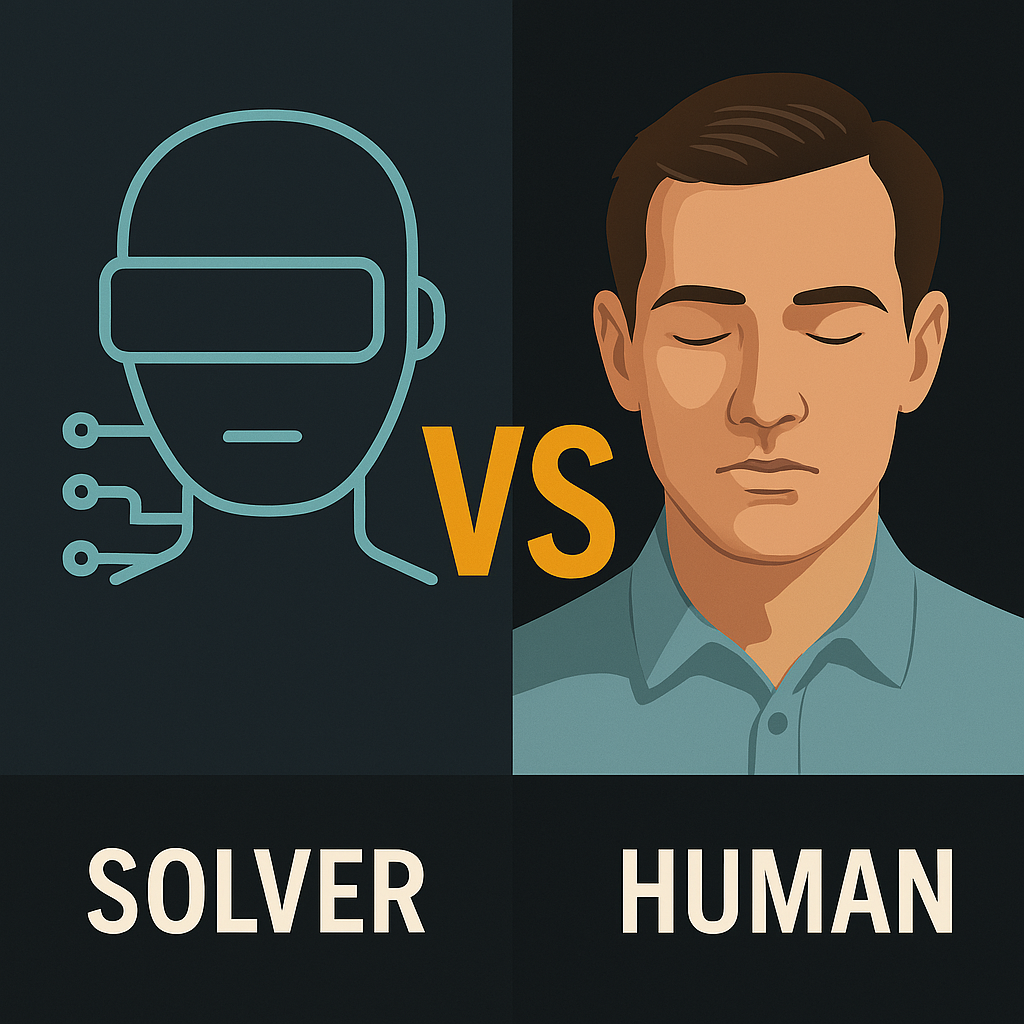
Poker is as much about emotional control as it is about strategy. The ability to bluff convincingly, to fold a strong hand when intuition dictates, or to call a massive bet with a marginal holding requires a blend of courage, restraint, and psychological insight. These are qualities honed through experience and self-awareness—traits that AI, devoid of consciousness or emotion, cannot emulate.
While AI can process probabilities and execute optimal strategies, it lacks the human capacity for empathy, intuition, and emotional nuance. These elements are not just peripheral to poker—they are central to its enduring appeal and complexity.
tools - not rules: playing in the age of ai
“Use the map, but don’t confuse it for the terrain.”
In today’s poker landscape, solvers have become indispensable tools for players aiming to refine their strategies. These programs offer insights into optimal play by analyzing countless scenarios, providing a “map” of theoretically sound decisions. However, it’s crucial to remember that while solvers can guide, they shouldn’t dictate every move.
SOLVERS AS TEACHERS: NOT COMMANDERS
ADJUSTING EXPLOITATIVELY VS PLAYING UNEXPLOITABLE
Solvers excel in controlled environments, offering balanced strategies that are unexploitable in theory. Yet, real-world poker is dynamic, filled with players who deviate from optimal play due to emotions, misunderstandings, or intentional deception. Relying solely on solver recommendations without considering the specific context can lead to missed opportunities or suboptimal decisions.
While GTO strategies aim for balance, exploitative play seeks to capitalize on opponents’ mistakes. For instance, if a player consistently folds to 3-bets, increasing your 3-bet frequency against them can be more profitable than adhering strictly to GTO guidelines. The key lies in observing opponents’ tendencies and adjusting accordingly, blending foundational GTO knowledge with adaptive strategies.
WHEN MATH MATTER-& WHEN PEOPLE MATTER MORE
CASE STUDY: FULL-RING CASH GAME EXPLOIT VS GTO FAIL
Mathematical precision is vital in poker, but so is understanding human behavior. Recognizing when an opponent is on tilt, identifying patterns in their play, or sensing hesitation can provide information that no solver can. Balancing analytical skills with emotional intelligence allows for more nuanced decision-making, especially in live settings where physical tells come into play.
Consider a scenario in a full-ring cash game where a player known for tight play suddenly becomes aggressive. A solver might suggest a standard response based on balanced ranges. However, recognizing the deviation from their usual behavior could indicate a strong hand or a bluff, prompting a different strategy. In such cases, relying solely on GTO recommendations without considering player-specific information can lead to costly mistakes.
THIS IS EXACTLY WHY POKERRAILBIRD.COM EMPHASIZES TOOLS - NOT RULES
Solvers, charts, and AI-driven models are useful — they help us see the shape of the game. But they are only tools, not commandments. They don’t replace the lived wisdom of real experience, real opponents, and real-time decisions. In fact, treating poker as a rule-bound game is a fast way to become predictable, exploitable, or worse — irrelevant.
AI, by design, plays through fixed logic trees and balanced range theory. But in live cash games or live tournaments, playing by a set of static rules in a dynamic game will eventually lead to disaster.
Take one of the most widely accepted “rules” among GTO purists:
“Always raise preflop if you’re going to enter the pot.”
Sounds solid, right? Until you’re on the button with a pair of twos, and five players have limped in ahead of you. A GTO solver might nudge you toward a raise — but what happens next? You reopen the action to the entire table, with a fragile hand, and likely end up in a bloated multi-way pot where you’re crushed by any overpair or dominated draw.
In that spot, folding or limping might actually be the most mathematically sound option — even though it’s technically “off book.” That’s not weak play. That’s intelligent adaptation based on real-world dynamics.
The game isn’t static. Neither are the people in it. And your strategy shouldn’t be either.
In poker, as in life, the map is not the terrain — and the solver is not the player.
In conclusion, while solvers provide valuable frameworks for understanding optimal play, they are tools to inform decisions, not rigid rules to follow blindly. Integrating solver insights with real-time observations and adaptability ensures a more holistic and effective approach to the game.
THE FUTURE OF HUMAN POKER
“We’re not obsolete. We’re just evolving.”
As artificial intelligence continues to influence the landscape of poker, the game is undergoing a transformation. Rather than rendering human players obsolete, AI is reshaping the way we approach, understand, and engage with poker.
In response to the rise of AI and real-time assistance tools, there’s a growing emphasis on live-only poker formats. These environments, free from digital aids, prioritize human intuition and interpersonal dynamics. Additionally, some communities are advocating for “anti-tech” leagues, where the use of solvers and tracking software is discouraged or banned, aiming to preserve the traditional essence of the game.
Simultaneously, hybrid learning models are emerging. Players are integrating AI tools into their study routines, using solvers to analyze hands and identify leaks, but relying on personal judgment and experience during actual gameplay. This balanced approach allows for growth without over-reliance on technology.
LESSONS FROM CHESS: MAGNUS CARLSEN'S DOMINANCE IN A SOLVED GAME
AI AS A MIRROR: REVEALING HUMAN LIMITS & POTENTIAL
Chess, often considered a “solved” game due to powerful engines like Stockfish and AlphaZero, offers valuable insights. Despite AI’s dominance, Magnus Carlsen remains a top player, not by mimicking machines, but by leveraging human strengths—intuition, creativity, and adaptability. Carlsen acknowledges the benefits of AI in preparation but emphasizes the importance of human insight during play. His approach underscores that even in domains heavily influenced by AI, human ingenuity retains its value.
AI doesn’t just challenge us; it reflects our limitations and potential. By highlighting areas where machines excel, we’re prompted to examine and enhance our own decision-making processes. In poker, this means recognizing patterns, understanding probabilities, and managing emotions more effectively. AI serves as a tool for self-improvement, pushing players to elevate their game.
CLOSING THOUGHTS: EMBRACING EVOLUTION
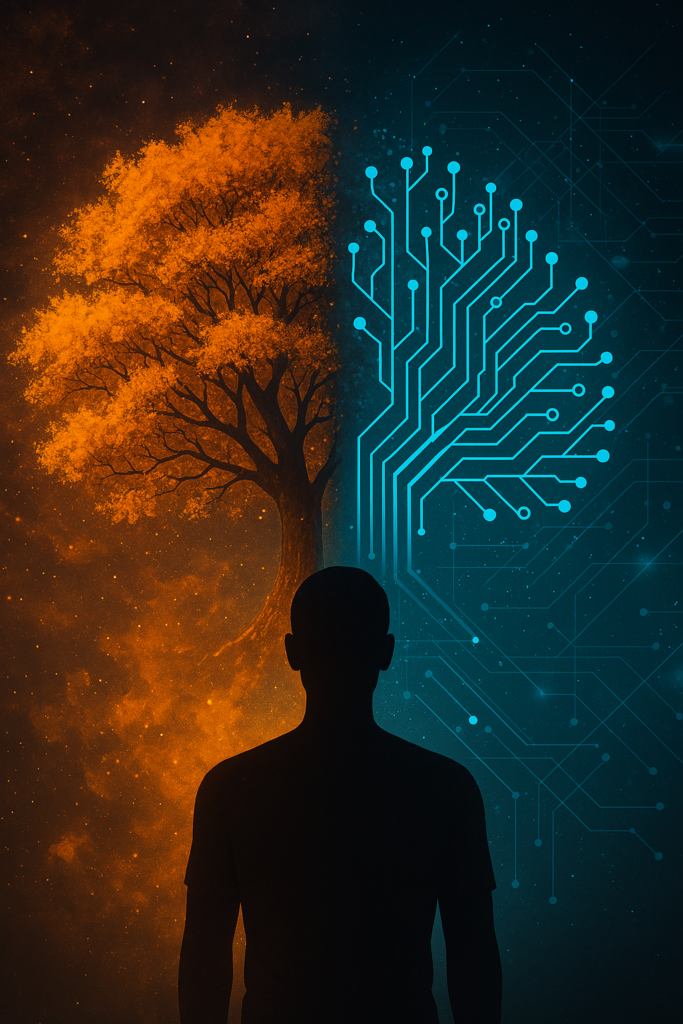
As we navigate this evolving landscape, it’s essential to remember that technology is a tool, not a replacement. Robert M. Pirsig aptly stated:
“The way to resolve the conflict between human values and technological needs is to break down the barriers of dualistic thought… a fusion of nature and the human spirit into a new kind of creation that transcends both.”
In poker, this fusion manifests as a harmonious blend of analytical tools and human intuition. By embracing both, we not only preserve the game’s integrity but also ensure its continued growth and relevance in the age of AI.
WHY WE STILL PLAY
Poker has always been more than a game. It’s a story — one written in moments of hesitation, courage, deception, and restraint. For nearly a thousand years, it has been a reflection of human thought, ambition, and emotion — and in the last decade, it has become something else as well: a proving ground for machines.
AI has changed poker. That’s no longer up for debate.
These systems can process millions of hands in minutes. They balance ranges better than the best professionals. They don’t tilt, they don’t tire, and they never forget a hand history.
There’s no second-guessing. No concern for table image. No moment where emotion interferes with execution.
But here’s what they also lack:
Fear.
Instinct.
The subtle tension in a player’s voice.
The flicker of confidence in someone’s eye after a perfectly timed check.
The psychological weight of knowing they’re being watched — and felt.
Poker is not just math.
It’s myth.
It’s mystery.
It’s human.
We will continue to use solvers. We will study charts. We’ll even let AI show us our flaws — because that’s what tools are for. But we will also continue to read people, to adapt, to bluff, to feel. Because that’s what playing is for.
The machine can solve the range. But it still can’t solve the player.
Poker is not dying.
It’s evolving.



Those are yours alright! . We at least need to get these people stealing images to start blogging! They probably just did a image search and grabbed them. They look good though!
I am not really wonderful with English but I get hold this real easy to understand.